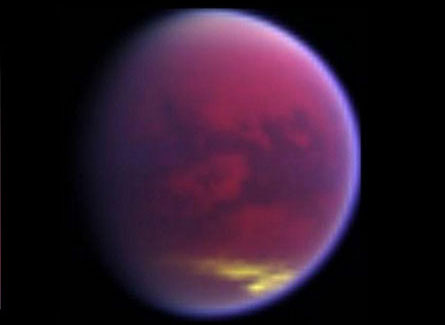When it comes to determining exactly where in the solar system life began, things have never been so up in the air. Scientists over the past decade have suggested deep-sea hydrothermal vents, underground aquifers, partially frozen lakes and even comets as locations for the origin of life.

Now an experiment that simulates chemical reactions in the atmosphere of Titan, Saturn’s haze-shrouded moon, adds a new location to the list of unexpected places where life could have begun — in the sky.
The study used radio waves as an energy source, simulating the action of ultraviolet radiation from the sun that strikes the top of Titan’s thick atmosphere and breaks apart molecules such as methane and molecular nitrogen. The experiment is the first to produce amino acids and the nucleotide bases that make up DNA and RNA — the basic ingredients of life — without the need for liquid water, says Sarah Hörst of the University of Arizona in Tucson. She and her colleagues presented the findings in Pasadena, Calif., October 7 at the annual meeting of the American Astronomical Society’s Division for Planetary Sciences.
The results suggest that Titan’s upper atmosphere, about 1,000 kilometers above the frigid moon’s surface, produces compounds capable of supporting life. And because planetary scientists believe that Titan represents a frozen snapshot of the early Earth, the study also indicates that terrestrial life might have formed within a primordial haze high above the planet rather than in a primordial soup on the surface, Hörst says.
Planetary scientist Jonathan Lunine of the University of Arizona, who was not part of the study, notes that the compounds found in the experiment “are relatively simple precursor molecules to life, and so there are a lot of additional steps between such molecules and life itself, most of which will likely require a liquid, such as water or methane.” However, he adds, everything that forms high in Titan’s atmosphere ends up in the moon’s lakes and seas of methane.
The study is provocative, Lunine says, because the Cassini spacecraft detected heavy ions in Titan’s atmosphere, but they were too massive for the craft’s instruments to identify. Amino acids were among the potential candidates for those heavy compounds, which were found in the terrestrial simulation.
To confirm that amino acids and nucleotide bases are actually produced in Titan’s atmosphere will require an orbiter that can carry instruments 100 to 200 kilometers deeper than Cassini does into Titan’s haze layer, Lunine says.







